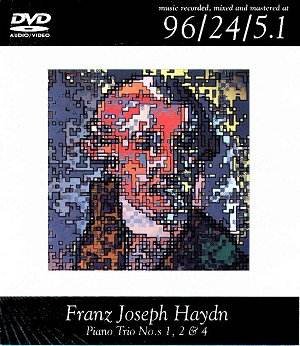One of the first things you learn when you start
to make recordings is that you don’t set the level of the loudest
violin note at 0VU. A violin note has a complex spiky waveform
and a good deal of ‘headroom’ is necessary to avoid clipping and
distortion. In spite of all those rhapsodies written by critics
who spend too much time listening to 78’s about ‘warm’ analogue
LP sound and ‘harsh’ CD’s, the CD was a big improvement in realism
and beauty of tone. And with DVD-Audio we make another big leap
in quality and realism of solo string sound recordings.
When I retired from my eight-to-five job I set
myself three goals to occupy my abundant new leisure time: I would
read Dostoyevsky, really get to know Parsifal, and hear
every one of the Haydn Symphonies. Brothers Karamazov was
enough Dostoyevsky, and Parsifal is actually easy to get
to know and love once you can sit still and breathe slowly for
five hours. The Haydn Symphonies took the longest time, and the
news was bad: they’re all terrific! Even with Mozart you can listen
to the last six and call it yourself a connoisseur. But not with
Haydn; you have to pay close attention to all 105+ of them, and
you’ll love every minute of doing it. And the same is true of
the Piano Trios, in fact all of his music. It’s all good. Pick
a miscellaneous Hoboken number to listen to it and expect to love
it. So when I put this disk on I expected it to be first rate,
but even so I was surprised and delighted.
String quartets are ‘symphonic;’ a number of
them are occasionally played by full symphony orchestras, for
better or for worse. Violin & piano sonatas are sort of like
songs. The piano trio form seems to lend itself to flamboyant,
passionate utterance, viz. the Smetana Trio, the Beethoven
"Archduke," and the Brahms Horn Trio. Although Haydn
is normally a reserved composer with a dignified, sardonic wit,
concerned more with craftsmanship than passion, even his piano
trios are more animated than his other works. "Haydn’s Piano
Trios have been undervalued....After the quartets they comprise
the largest and greatest corpus of [his] chamber music..."
says New Grove.* It is then explained that one of the difficulties
in both Haydn’s violin sonatas and his piano trios lies in the
tendency for the piano to be the solo instrument and the strings
the accompanists, even though in slow movements the violin will
usually carry a melody. In other words, the violinist complains
that he’s not the ‘star’ all the time, so he takes his bow and
his box and goes home, and the Haydn doesn’t get played.
But these players are obviously good friends
and love playing together, and are happy to take turns being star
performer. They play these beautiful works with enthusiasm and
have a lot of fun doing it.
The G major piano trio has as its finale the
famous ‘Gypsy Rondo’ and may have inspired Brahms to include a
Hungarian rondo as the finale of his piano quartet in g. We need
to be reminded that Haydn was a Hungarian composer, and these
Rumanian artists give the music just the right East-European flavour.
To see how this disk would play in a DVD (video)
player I put it in my new Sony DVD/SACD player which contains
a 96kHz audio chip. There is also a firm notice in the booklet
that it does not (sniff!) play DVD-Audio disks.
The AIX logo appeared on the screen (unfortunately not a silent
one) and then the audio set-up menu, and when I clicked nothing,
almost at once the 96kHz PCM stereo track began to play. Even
in two channel stereo there was a magical clarity. Upon returning
to the audio set-up menu, I selected DTS surround sound and there
I was, seated at the piano, with the violin to the front and the
cello to the back. Every note of every instrument was brilliantly
clear. I thought it couldn’t get any better than this, but when
I moved the disk to my DVD-Audio player, both the stereo and surround
tracks expanded into a new greater clarity and detail. So you
can buy this disk now and enjoy it on your DVD player, knowing
that when you get a dedicated DVD-Audio player you still have
something to look forward to.
Hopefully this series may be extended with more
recordings in the future. That would be delightful! Watch this
space for news.
*James Webster and Georg Feder
Paul
Shoemaker
